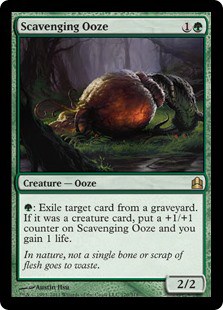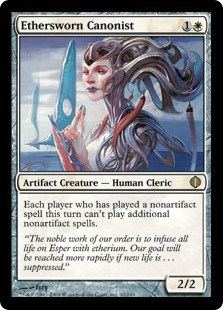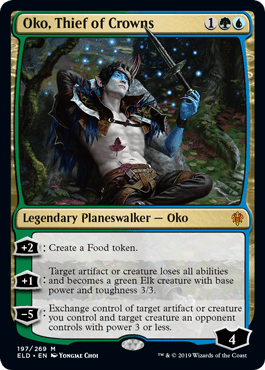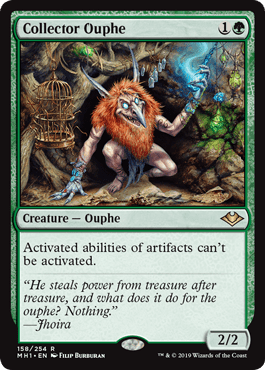It’s a little surreal to be sitting here writing an article on why Gaddock Teeg, the godfather of silver bullets, has fallen out of favour for Legacy Maverick. Printed in 2007 through Lorwyn, Teeg (as he’s known within the magic community) has always had a special place in Maverick across all of its archetypes. Starting off as a great sideboard card for combo and Miracles, the cenn of Kinsbaile has been a maindeck Green Sun’s Zenith target for the better half of the last decade.
Teeg has always taken the role of the guardian on the frontline that creature-based decks have needed to keep opposing board wipes, combo pieces and game-winning spells from ever being cast. In the situations where he’s paired with protection from Mother of Runes or Sylvan Safekeeper, Teeg can sometimes create locks your opponent just can’t break free from.

Having a Gaddock Teeg on the battlefield means you’re preventing your opponent from casting format-defining spells such as:
- Terminus
- Supreme Verdict
- Massacre
- Tendrils of Agony
- Empty the Warrens
- Ad Nauseam
- Goblin Charbelcher
- Natural Order
- Aluren
- Green Sun’s Zenith
- Sneak Attack
- Force of Will
- Planeswalkers like Jace, the Mind Sculptor, Chandra, Torch of Defiance and Karn, the Great Creator.
I could add many other notable cards to this list, but I believe these 15 give a clear understanding of how much work Teeg does for keeping Maverick in the running against some of the most unfair strategies in the format.
For a cost of just a green and a white mana, Teeg is undeniably powerful. Imagine having a Meddling Mage that, on resolution, locked your Miracles opponent out of casting not just 1 spell, but Entreat the Angels, Jace, the Mind Sculptor, Force of Will, Supreme Verdict AND Terminus. One creature that shuts down a whole storm deck by not allowing your opponent to cast Tendrils of Agony, Empty the Warrens, Past in Flames, Ad Nauseam or Peer into the Abyss. You’ve come up against a red prison player? Well, with Teeg on the field, you’re not only blocking a sweeper like Fiery Confluence from decimating your boardstate, you’re also stopping game-winning planeswalkers such as Chandra, Torch of Defiance and Karn, the Great Creator from taking over. Even against un-favoured matchups like Elves, Teeg gives you hope by shutting off Green Sun’s Zenith and Natural Order.
One of the decks Teeg really assisted Maverick with its ability to keep creatures on the battlefield was Miracles. Right now, Miracles as an archetype isn’t the powerhouse it once was, meaning Terminus, Supreme Verdict and Jace are currently seeing little to no play. Leaner control/midrange decks with 3CMC board wipes such as Dead of Winter and planeswalkers like Oko, Thief of Crowns and Teferi, Time Raveler have diminished Teeg’s effectiveness to keep opponents off crucial spells. This has pushed it further into a niche corner of matchups where it’s still a relevant piece of disruption.
Let’s quickly have a look at what a silver bullet actually is.
What is a silver bullet?
“A silver bullet is a specific solution card. It is incredibly powerful against a certain type of card or archetype, but useless or inefficient otherwise. An example of a silver bullet is Moat, because it stops almost all creatures, but is useless against flying creatures and decks that do not use creatures to win (such as Burn, Combo and their variants). A hoser is a particular subtype of silver bullet.
The term is used fairly widely depending on situation. If your deck only contains one answer to a certain situation, then that card is your silver bullet. If there are many cards in a format that significantly damage specific decks but one is significantly better, then that is a silver bullet. Often these cards find a place in side boards as a meta-game choice or as a wishboard.” – MTGWiki
The biggest advantage silver bullets give Maverick is having pseudo-copies with Green Sun’s Zenith. If you’re playing 1 Gaddock Teeg and 4 Green Sun’s Zenith, you effectively have 5 copies of Teeg in your deck. Not only that, but when you cast your Zenith, if it gets countered, you’re not losing your copy of Teeg. This might be a simple thought, but it really reinforces and identifies the power of Green Sun’s Zenith.
Speaking of Green Sun’s Zenith, playing Teeg in Maverick does have its minor setbacks, especially when your deck plays 4 Zenith. However, this is a great example of how it’s worth taking a hit by one of your own spells if it’s going to have a more drastic effect on your opponent’s gameplan. What I mean by this is that although you’re cutting off the engine of your deck once Teeg is in play, it’s not the end of the world. It may be the end of your opponent’s world though, relying on spells they can no longer cast to win the game.
Another fault of silver-bullet creatures is that they have a great impact on some matchups, but in others, they might as well be a vanilla creature. Drawing Gaddock Teeg against a deck like Goblins or Death & Taxes gives you a great insight into how poor Teeg lines up against some matchups. In short, Gaddock Teeg is feast or famine in a linear metagame.
The importance of Interaction:
It’s common knowledge that Maverick is quite a fair, creature-based deck that tends to push its advantage by going wide on the board with a mix of disruptive creatures and heavy-hitting threats. As you can see from the list of powerful spells above, it’s vital to find the right mix of disruption and pressure if you’re wanting to pilot a creature-based archetype in Legacy.
Without Teeg, the deck is left with next to no defences from your combo opponent breezing through to victory or an opposing board wipe clearing all pressure being applied. This is where Teeg really shines – disrupting your opponent enough to help the rest of your creatures finish off your opponent while the answer to your board may be caught withering in their hand. However, he can’t do it all himself.



Maverick is a deck that doesn’t just rely on one creature, but building pressure through multiple troublesome creatures. Ever heard the saying “the whole is greater than the sum of its parts”? That’s a great way to look at the creature suite on offer in Maverick. You need to keep applying extra disruption to the board to keep opponents at bay while also building and applying pressure.
Thalia Guardian of Thraben, Scavenging Ooze and Ethersworn Canonist are all great examples of creatures that not only apply pressure, but also disrupt and trip up opponents’ strategies. However, by themselves, they may only be a small speed bump for your opponent. Side by side, they become a whole different beast and create a tremendous blockade for your opponent to navigate through. You can’t just rely on landing one hatebear and thinking you’ve got control of the game – this type of mindset is going to blow up in your face.
Teeg’s Current position in Legacy
Arguably once the best silver bullets to tutor through a Green Sun’s Zenith, Teeg has recently dropped in popularity across the board, relegated to the deck’s sideboard or completely out of the 75.
I attribute this to two key factors. The wave of new, powerful and CMC-efficient spells printed over the past few sets and an overall shift in the Legacy metagame. When it comes to a silver bullet, you need to understand its role in the metagame and if the need for it is warranted. Right now, I believe the current need for Teeg is questionable. Let’s dive into the two factors mentioned above and give you a better understanding of why Teeg isn’t seeing as much play as he used to.
The Legacy metagame:
Legacy is much different to what it was even 2 years ago. Before the printing of Oko, the Breach meta and of course companions, we’ve seen a flurry of different metagames than most players would have liked to have seen. I remember when Karn, the Great Creator and Narset, Parter of Veils were all the hype. I feel because of these cheaper, efficient planeswalkers we’ve seen control / midrange decks adjust accordingly. No longer is there a need for expensive boardwipes and 4CMC or higher planeswalkers – 3CMC is the new curve topper. Removal for single creatures has also been boosted so the need for boardwipes probably isn’t as high now as it was a few sets back.
Maybe you played Teeg because you wanted to keep Jace and Terminus away from the stack. Well, now it’s going to look a little silly when your board gets wiped by a Dead of Winter. Red Prison also has some new toys with Bonecrusher Giant seeing maindeck play as a piece of removal / threat and Abrade is never too far away either (mostly sideboard). Even ANT and TES have been seen to maindeck Grapeshot as a tutor / wishclaw target, not only as an alternate win condition but also as an out to deal with G1 threats like Teeg.
When the metagame also moves closer to most decks playing creatures, I feel Teeg slowly becomes worse. It’s not going to be a great card against Eldrazi, Esper Vial, Delver variants or in the mirror, so there are a fair amount of times where you can’t take it out of your deck fast enough when boarding.
The big question is: what are you wanting to disrupt with Teeg? Where’s the need for Teeg in the metagame you’re going to play in? If you play in a local meta where there are players who just like to play Miracles, then sure, Teeg sounds like it has a home in your store. But if you’re wanting to play on MTGO, you need to have a pretty good reason right now to be playing Teeg in your maindeck. Even in your sideboard, some players would argue it’s just worse than other hate like Deafening Silence or Mindbreak Trap. If your opponent is expecting creature-based hate and sideboards accordingly, would you really want to be bringing in Teeg when you could have other permanent-type options available?
New printings:



As I said above, gone are the days where control decks need to rely on Supreme Verdict or Terminus to deal with creatures. Dead of Winter, Oko, Thief of Crowns and Teferi, Time Raveler are three massive printings for opponents to deal with threats and, unfortunately, creatures like Gaddock Teeg. Not only do all of these fly under the radar of Teeg, they have a huge impact on the game.
Dead of Winter
Dead of Winter (DoW) is the card I am most scared of in Legacy right now. As a fan of going wide on the board, Dead of Winter is going to heavily punish me if I’m not smart about it. Usually played alongside spells such as Astrolabe, Ice-Fang Coatl and a manabase filled with snow-covered basic lands, it’s usually your Knight of the Reliquarys (if you’re lucky) that are still standing after a DoW has been cast. Similar cards like Toxic Deluge have been around for some time now, so most Maverick players are used to getting caught out by a sweeper even with a Teeg on the field. What’s different is at least Deluge also took a chunk of your opponent’s life total with it. Opponents also had to be cautious about the amount of life they would pay, as paying 1 life above the toughness of a Knight could allow the Maverick player to steal games by fetching a Wasteland and destroying one of your own lands to keep the Knight alive for one last lethal swing.
DoW isn’t so easy to play around though. The typical start of T1 Astrolabe and T2 Ice-Fang means with snow-basics, a T3 Dead of Winter is going to already be a -5/-5. Even if you’re lucky to keep a Knight on the field, the Dead of Winter doesn’t affect the snow-creature Ice-Fang, so you’re going to need removal for that before you can start pressuring your opponent.
However, just because Teeg doesn’t stop it doesn’t mean it’s the end of the world. Have some fun with finding alternative solutions. Maindeck Sanctum Prelate, and hand disruption like Thoughtseize or Inquisition of Kozilek might take your opponent by surprise. If you’re lucky, you might be able to respond to the cast with some removal for Astrolabe or Ice-Fang to counter the effectiveness of the -x/-x – pretty risky though. I wouldn’t truly offer that as a solution.
Oko, Thief of Crowns & Teferi, Time Raveler
Oko has really put a strain on creature-based decks, constricting their ability to apply pressure through creatures with size and utility. Have a Knight that can fetch different lands? It’s an elk. Have a disruptive creature like Teeg? No, you don’t – now you have an elk. We understand the effectiveness of Oko and the way it bullies creature-based decks, but this is another reason why Teeg is seeing less play. Many control decks used to heavily rely on 1CMC removal like Swords to Plowshares to remove a creature like Teeg. Now, they have multiple avenues of dealing with creatures that are affecting their game plan through cheaper planeswalkers or other removal like Council’s Judgment.
Teferi also offers midrange / control decks a nice out to troublesome permanents. If your opponent didn’t have a counterspell for Teeg when he first made it onto the stack, maybe they have drawn into one. This means they can bounce him and counter him on the way back down.
Ice-Fan Coatl
Ice-Fan Coatl is also a card I’d like to discuss as it does shift how Maverick pilots have to pick their opponents when applying pressure. Before Ice-Fang, it was sometimes risky attacking with a disruptive creature like Gaddock Teeg or Sanctum Prelate because an ambushing Snapcaster Mage may come out of nowhere, trade with your disruption and unlock your opponent’s hand. This is where exalted plays an excellent role, giving these speed-bump disruption creatures the ability to also apply pressure without the need to take a 2/1 body into consideration. Thalia isn’t mentioned here as she’s always had it easy with combat thanks to first strike.

Now we have to take Ice-Fang into consideration, and unfortunately deathtouch > exalted. Most of the disruptive creatures Maverick plays are speed bumps. They aren’t going to lock your opponent out forever (in most cases) so it’s arguable that using them to apply pressure is just as important as keeping your opponent off their strategy. However, now we’re in the situation of attacking and losing our piece of disruption to a creature that replaces itself with a new card. It may only be keeping me from attacking with my creature, but Ice-Fang or even open UG-mana can be really intimidating.
Collector Ouphe
The printing of Collector Ouphe in Modern Horizons was one of the best silver-bullet creatures Maverick has had for some time. At this point in time, Stoneforge Mystic was a popular 2-4 of in most Maverick builds, playing alongside a suite of equipment in Umezawa’s Jitte, Batterskull and sometimes a 3rd piece such as a sword. Since then, Ouphe slowly made its way into Maverick’s 75 and now part of the maindeck silver-bullet package for most builds. This does of course have some impact on the role of equipment in the deck, but much like the relationship between Teeg and Zenith, Ouphe is just too good to pass up.

You wouldn’t think about it on first glance, but Ouphe has kinda taken the spot of Teeg in Maverick’s maindeck. It’s great against the current metagame of combo decks as it shuts off:
- Lion’s Eye Diamond
- Lotus Petal
- Chrome Mox
- Mox Opal
- Wishclaw Talisman
- Grim Monolith
- Walking Ballista
- Grindstone
- Mox Diamond
- Aether Vial
- Equipment pieces
- Arcum’s Astrolabe
- Artifact lands (Painter decks mainly – sometimes you can catch out Urza)
Ouphe is just better against a wider range of decks than Teeg, shutting down Aether Vial against the fair decks where Teeg is next to useless and catching out Loam opponents by cutting off their Mox Diamonds. Ouphe can catch opponents off-guard as well when fetching for it off a Green Sun’s Zenith. Most opponents I’ve played against have not activated their Vials, Jitte or Ratchet Bombs because they thought I was getting something like Qasali Pridemage.
Pro Tip: Don’t rely on Ouphe alone against decks like ANT and TES. These decks can still go off using their Petals and LEDs to increase storm count if they can find other ways to accelerate their mana.
Should you maindeck or sideboard Gaddock Teeg?
This big issue is that the role of Gaddock Teeg is no longer vital to keep Maverick on its gameplan, but also to keep opponents off theirs. We now also have multiple options for maindeck combo hate in Ouphe and Sanctum Prelate with some lists even moving towards maindeck hand disruption. I did drop Teeg from my Maverick list, but after I competed testing, I’ve found a slot for him in my sideboard.
Although the relevance is much different to the metagame of past, he still disrupts enough for me to consider him a viable sideboard card for combo / control decks. Against a deck like ANT or TES, a Teeg as early as T2 usually buys Maverick enough time to setup other pieces of disruption or get my beat-down plan moving. It’s not about locking out an opponent, it’s about applying disruption for as long as my pressure needs.
I think a big part of deciding if you should play Teeg is looking at your local metagame or the MTGO metagame and making a decision yourself. If you’re not playing Teeg, what are you doing to disrupt those decks? Is Ouphe enough?
How do you feel about Gaddock Teeg, both playing with and against it?
Let me know in the comments below 🙂








I definitely think you’re right, I’ve found myself siding my Teeg out very often in this delver/snoko meta. He just doesn’t hit the threats that he used to; granted, I can’t tutor him up fast enough against the one storm player around me. But aside from Storm and Miracles, he’s stone cold useless. I love collector ouphe, I think it’s the start of a new direction of green hatebears. I really like the idea of getting a few Allosaurus Shepherd to really fight against those blue decks; while he doesn’t do anything against sweepers he DOES force our GSZ through forces, which might be good enough to justify its current pricetag.
I don’t like Teeg very much, but it is in line with Maverick’s gameplan: if he is not effective, the plan is worst, not the card.
Having said that, he does not even stop Force of Negation. He is in an all time low.